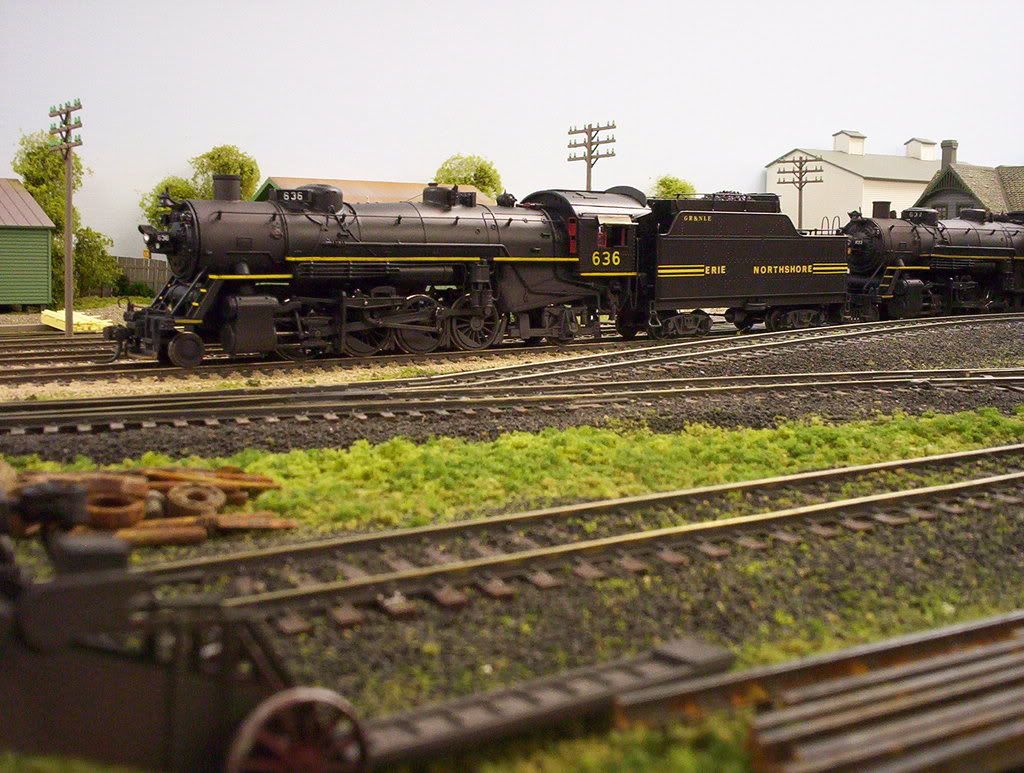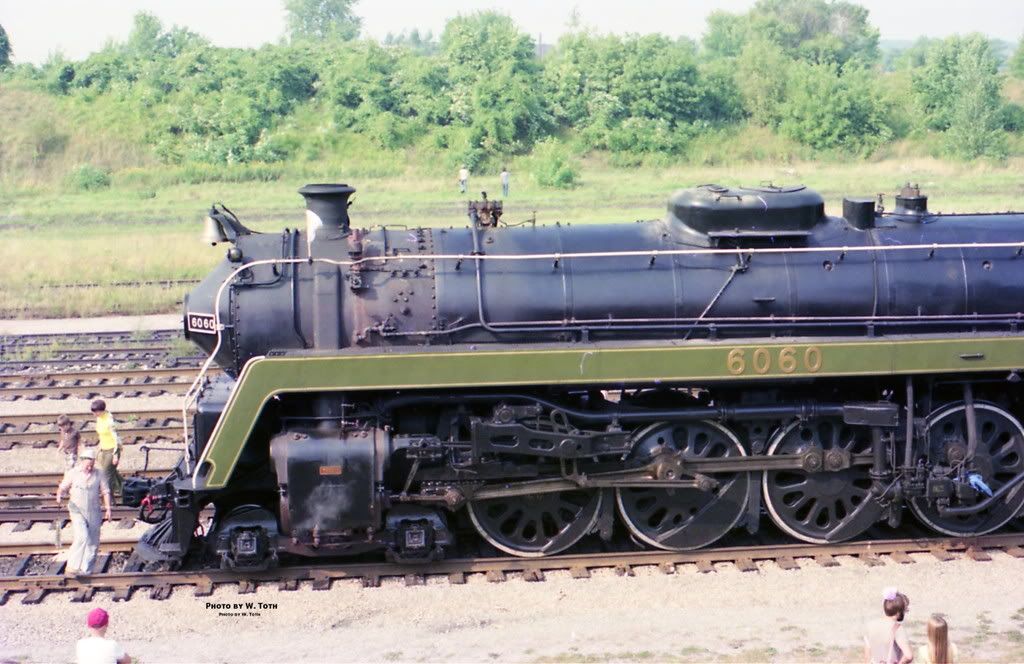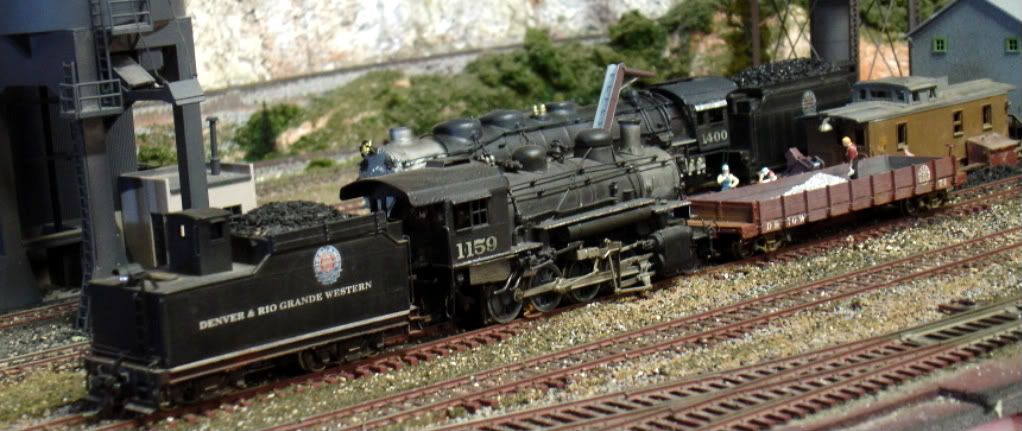Hi everyone, I am in the process of repainting one of my locomotives. The front of the smokebox is of course graphite. Which paint should I use for this? Which graphite paint is the most accurate shade to use? Thanks.
I’ve used Neolube from Micromark with good results. However, this is a suspension of graphite in isopropyl alcohol and not a paint—as such it will rub off with excessive handling. But for me it looks really nice and it is easy to apply.
Wayne
Locojunkie:
The graphite color pretty much depends on the railroad you’re modeling, it can be everything from a ‘shiny’ black to bright silver, and almost any shade in between. For instance, I model Rio Grande standard gauge steam, and depending on when the locomotive has been ‘shopped’, the graphite is everything from a light silvery gray to a bright silver.
I’ve settled on a ‘mid-silver’ graphite for my smokeboxes and fireboxes, and is a mixture of 60% Floquil’s Weathered Black and 40% Bright Silver.
If you’re modeling your loco after a specific railroad, I’d recommend that you try and get a color photo of one of the steam locomotives and experiment with various combinations of black and silver to match the shade of that particular locomotive. Some railroads painted the smokebox front a bright silver to make the locomotive more visible at grade crossings, but used a darker shade of graphite for the smoke-box and firebox.
So it pretty much boils down to what specific railroad you’re modeling. Of course, if you’re free-lancing, you can paint the locomotive almost any shade of graphite you choose.
Tom
Thanks! I am modeling Southern railway freight. It seems that the smoke box had different graphite coatings for freight and passenger power. I put testors master graphite paint on a NKP 2-8-4 and it turned out perfect. I was thinking of using it again on my Southern locomotive but didnt think this was correct. It seems darker then what it should be on the Southern locomotive.
I have used Scalecoat Graphite and Oil for my smokeboxes and I think it will give you the look you are looking for. A Custom Painter friend of mine used it on the Southern PS4’s that he painted.
Rick J[2c]
Keep in mind the “fresh from the paint shop” color wouldn’t last very long, pretty soon it would have soot and grime on it and be darker and less shiny than when new.
Floquil also offers a Graphite colour, although you can mix your own using black and silver. If you want a lighter version, add some white or grey. Sorry, but I can’t find photos of the locos done with the Floquil version.
Personally, I prefer a more “baked” look to those areas that get hot.

Wayne
Do you use the same color graphite on the firebox as on the smokebox?
Wayne:
I’ve found the Floquil graphite VERY varied from batch to batch–don’t know why. An earlier bottle I bought about five years ago was a bluish-silver gray in color, and the last time I bought it, it was almost a gloss silvery black. That’s one of the reasons I started mixing my own.
Tom
The origin of the graphite smoke box and fire box color was because there wasn’t any paint that could withstand the temperatures. The hot surfaces would be wiped down nightly with a mix of graphite and linseed oil to prevent the iron/steel from deteriorating. Color would depend on the mix and other factors. Similarly, Russian iron and planished iron were used as “deluxe” boiler jacket materials in the 19th Century. These surfaces would not have a much soot or grime on them due to the care.
It wasn’t until close to WW1 that paints that could withstand the temperatures were routinely being made and used. The initial high temperature paints were generally (unpolished) aluminum in color, which fit in with the graphite color tradition.
Some railroads maintained the tradition of colorful engines well into the 20th Century, especially for name passenger trains.
Fred W
A number of years ago, an old engineer from the N&W said that the color of the graphited smokeboxes would vary depending on the amount of graphite mixed with the oil. the roundhouse would keep the mixture in a barrel, and as the mixture would be used, the worker would just throw in a scoop of powdered graphite, and a gallon or two of oil, stir the mix a bit with long pole, and slop it onto the smokebox. Coming out of the roundhouse, the color would be fairly dark, but as the day wore on, the oil would evaporate, leaving the silvery graphite. And BTW, they weren’t real careful about coloring inside the lines. So don’t worry if the brush slips a bit.
I. like Wayne, use Neolube, brushed on. I figure if the prototype uses graphite, it’s good enough for me. and I rarely handle my steamers by the smokebox… :

Mine was done with paint, either Floquil or Pollyscale, and was based on the colours which I saw on various in-service steam locos:

Wayne
Wayne:
I like that–it looks like what graphite would be after some running.
Here’s my Rio Grande ‘fresh from the shop’ look:

And the same graphite mixture after some ‘running in’.

Tom
I mix my own similar to Twhite. I use a mixture of Pollyscale bright silver and mix in engine black and earth until I get a color I like.
!(http://i27.photobucket.com/albums/c154/onequiknova/scratchbuilt steam/cbqT2006.jpg)


Tom, I always enjoy seeing photos of your layout and those good-looking locomotives. [tup]
Onequiknova, very nicely-done locos. [tup] What’s the purpose of the strap-like assemblies on the valve gear of that Mike? I’ve seen them in prototype photos, too, but not any accompanying explanation.
Wayne
Thanks Wayne. I honestly don’t know what they’re for. They were on the prototype, so I added them when I built the model. Many CB&Q loco’s with Walschaerts valve gear had them, but not all of them. I can only assume they are a “step” to stand on while servicing the valve gear.
John
Thanks everyone, I think I would get better results if I mix my own it sounds like. Looking at the photo of the locomotive I have in mind, I do believe the “fresh out of the shop” look of the graphite seems to be silver in color but the grime definetly makes it look black in spots. I have used floquil in the past and I too have experienced varied results from it, which is why I posted this question in the first place. The floquil didnt give me the results I wanted. The testors master graphite color definetly made my NKP pop! Again, thanks.